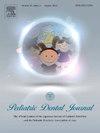聚羧酸水泥中硝酸钾直接髓盖龋齿,未成熟恒磨牙:一个18个月的随机对照试验
IF 0.8
Q4 DENTISTRY, ORAL SURGERY & MEDICINE
引用次数: 0
摘要
目的:本研究旨在比较硝酸钾聚羧酸盐水泥(KNO3/PCA)与三氧化二矿骨料(MTA)在龋齿、未成熟恒磨牙直接髓盖(DPC)中的临床和影像学成功。材料和方法一项双臂平行随机试验纳入了100名患有104例M的儿童,并被平等分配。通过临床和影像学检查评估成功率。卡方检验和Fisher精确检验用于比较临床和放射学的成功率。采用独立样本t检验检验放射学参数的百分比变化。采用一般线性模型(GLM)检验了时间对射线照相参数平均值的影响。显著水平设为5%。结果随访18个月后,KNO3/PCA和MTA的总成功率分别为90.4%和92.3% (p >;0.05)。同样,在随访期间,两组间的根系成熟指标也没有显著差异(p >;0.05)。结论KNO3/PCA是治疗龋齿、未成熟恒牙DPC的有效方法,临床和影像学结果与MTA相当。本文章由计算机程序翻译,如有差异,请以英文原文为准。
Potassium nitrate in polycarboxylate cement in direct pulp capping of carious, immature permanent molars: An 18-month randomised controlled trail
Aim
The current study aimed to compare the clinical and radiographic success of potassium nitrate in polycarboxylate cement (KNO3/PCA) compared to mineral trioxide aggregate (MTA) in direct pulp capping (DPC) of carious, immature permanent molars over an 18-month follow-up.
Materials and methods
A two-armed parallel randomised trial included one hundred children with 104 M have been included and assigned equally. The success rate was evaluated clinically and radiographically. Chi-square and Fisher's exact tests were used to compare the clinical and radiographic success rates. The percentage change in radiographic parameters was tested using an independent sample t-test. The effect of time on the mean values of radiographic parameters was tested using the general linear model (GLM). A significant level was set at 5%.
Results
The overall success rates after 18 months of follow-up for KNO3/PCA and MTA were 90.4% and 92.3%, respectively (p > 0.05). Similarly, root maturation indicators showed no significant difference between the two groups over the follow-up (p > 0.05).
Conclusion
With comparable clinical and radiographic results to MTA, KNO3/PCA is an effective treatment option in the DPC of carious, immature permanent teeth.
求助全文
通过发布文献求助,成功后即可免费获取论文全文。
去求助
来源期刊

Pediatric Dental Journal
DENTISTRY, ORAL SURGERY & MEDICINE-
CiteScore
1.40
自引率
0.00%
发文量
24
审稿时长
26 days
 求助内容:
求助内容: 应助结果提醒方式:
应助结果提醒方式:


